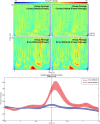BrainWave: A Matlab Toolbox for Beamformer Source Analysis of MEG Data
- PMID: 30186107
- PMCID: PMC6113377
- DOI: 10.3389/fnins.2018.00587
BrainWave: A Matlab Toolbox for Beamformer Source Analysis of MEG Data
Abstract
BrainWave is an easy-to-use Matlab toolbox for the analysis of magnetoencephalography data. It provides a graphical user interface for performing minimum-variance beamforming analysis with rapid and interactive visualization of evoked and induced brain activity. This article provides an overview of the main features of BrainWave with a step-by-step demonstration of how to proceed from raw experimental data to group source images and time series analyses. This includes data selection and pre-processing, magnetic resonance image co-registration and normalization procedures, and the generation of volumetric (whole-brain) or cortical surface based source images, and corresponding source time series as virtual sensor waveforms and their time-frequency representations. We illustrate these steps using example data from a recently published study on response inhibition (Isabella et al., 2015) using the sustained attention to response task paradigm in 12 healthy adult participants. In this task participants were required to press a button with their right index finger to a rapidly presented series of numerical digits and withhold their response to an infrequently presented target digit. This paradigm elicited movement-locked brain responses, as well as task-related modulation of brain rhythmic activity in different frequency bands (e.g., theta, beta, and gamma), and is used to illustrate two different types of source reconstruction implemented in the BrainWave toolbox: (1) event-related beamforming of averaged brain responses and (2) beamformer analysis of modulation of rhythmic brain activity using the synthetic aperture magnetometry algorithm. We also demonstrate the ability to generate group contrast images between different response types, using the example of frontal theta activation patterns during error responses (failure to withhold on target trials). BrainWave is free academic software available for download at http://cheynelab.utoronto.ca/brainwave along with supporting software and documentation. The development of the BrainWave toolbox was supported by grants from the Canadian Institutes of Health Research, the National Research and Engineering Research Council of Canada, and the Ontario Brain Institute.
Keywords: Matlab toolbox; beamforming; group analysis; magnetoencephalography; response inhibition; source analysis.
Figures








References
-
- Ad-Dab’bagh Y., Einarson D., Lyttelton O., Muehlboeck J.-S., Mok K., Ivanov O., et al. (2005). “The CIVET image-processing environment: a fully automated comprehensive pipeline for anatomical neuroimaging research,” in Proceedings of the 12th Annual Meeting of the Organization for Human Brain Mapping, Florence.
-
- Bardouille T., Herdman A. T., Chau W., Pantev C. A. (2004). Spatiotemporal approach to cortical mapping using synthetic aperture magnetometry. Brain Cogn. 54 175–176. - PubMed
LinkOut - more resources
Full Text Sources
Other Literature Sources

